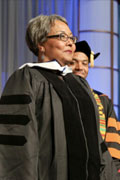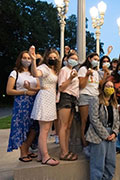Brandeis Alumni, Family and Friends
Faculty Seeking Funding
The Office of Corporate and Foundation Relations (CFR) is a resource for members of the Brandeis community interested in securing support from independent and corporate foundations for their research, teaching and outreach projects.
This website is meant to guide you through the process of seeking foundation support for your work. In most cases, we encourage you to contact a foundation directly to determine if your project aligns with its mission and strategy and to learn more about the process for requesting support.
The entire process—from initial contact to final decision by a foundation’s board of directors—takes six months to a year, on average. You are best advised to start the process very well in advance of the time the funding will be needed.
Please review the resources below and contact us when you are ready to request funding, or if we can help in any way.
You must contact the Office of Corporate and Foundation Relations before soliciting any foundation for fundraising purposes. The University has active relationships with many foundations, and all activities with these entities must be coordinated carefully. In some cases, competing priorities will be resolved by the dean or provost.
CFR works closely with our colleagues in the Office of Research Administration (ORA) to assist faculty and others with pursuing external funding from private organizations. ORA ensures that all proposals and awards are administered in compliance with federal laws and regulations and with Brandeis' policies on sponsored programs, and that the University meets its obligations to external sponsors.
When submitting a grant proposal for a sponsored program or project, regardless of the nature of the funding agency, the Brandeis investigator must always contact ORA and follow the policies it administers.
The Grant-Seeking Process
Use the anchor links below to skip to the section of interest to you.
- Prepare Your Search
- Identify Potential Funders
- Prepare a Letter of Inquiry
- Write a Proposal
- Submit the Proposal
- Steward the Gift/Grant
Step One: Prepare Your Search
Foundations are increasingly committed to achieving measurable impact on specific social challenges—their “social return on investment”—and even to specific strategies for accomplishing these aims. Even relatively small family foundations now require formal plans for assessing the impact of the proposed project. Answering the questions below will help prepare you to approach any private funder:
Articulate the Need
- What problem/need will your project address?
- Why is it important, and why is it important to address at this time?
Describe the Approach
- How will you address this problem/need?
- What methods, tools, and approaches will you take?
- What distinguishes your approach from others’ working in this area?
Define the Impact
- What will be the outcome or impact of the project?
- Will it have an effect beyond the University or Waltham?
- Who will benefit from your research?
- What audience will you engage in your project?
- How will you define and evaluate the project’s success?
Showcase Leadership
- Who will design, lead, and manage the project?
- Who will staff the project?
- What distinctively qualifies you to undertake it?
Timeframe/Funding
- What are your deadlines and financial needs for the project?
- Will the project require multiple funders?
- How might you sustain the project after a foundation grant expires?
- How will the University or institutional resources contribute to the project?
Step Two: Identify Potential Funders
Now that your idea is sharpened, you are ready to begin researching prospects, which can be done through the following online resources through the Library's foundation resource center.
Once you have identified a prospective funder, determine alignment of the foundation’s interest to your project (including the scale of funding) by reviewing previously-supported organizations and programs. This information can often be found on a foundation’s website, in its annual report, or in any of its other publications, including the foundation’s Form 990 for the past 2-3 years.
The 990 or 990-PF are the tax returns for public charities and private foundations, respectively, and can be searched online. These public documents provide fiscal data, names of trustees and officers, application information, and a list of grants made during a particular year. Contact CFR for assistance with accessing or interpreting any of this information.
If you do not have prospective funders in mind, follow the tips below to determine which companies and foundations are funding similar work in your field:
- Speak with colleagues—inside and outside of your department—to learn about research/project synergies and about the philanthropic landscape.
- Look at the organizations that fund your professional associations.
- Examine the supporters of research groups or consortia that are pursuing related work.
- Review articles in research journals—funders are often acknowledged.
- Note the funders that are recognized at events.
Step Three: Prepare a Letter of Inquiry
A letter of inquiry (LOI) is often the initial threshold in the proposal process. Upon reviewing an applicant’s LOI, a funder will decide whether or not they wish to request a full proposal. If an LOI is requested, then it is typically a concise (2-3 pages), but thorough, presentation of the need or problem, the proposed solution, and your qualifications. Follow the guidelines, but accentuate methodology/activities and the sustainability/durability of the project. Use the following resources:
- How to Write an LOI to a Foundation (About.com)
- What should be included in an LOI? (Foundation Center/Grant Space)
If a detailed budget is requested (that is, more than a summary amount), please coordinate with your departmental administrators.
Step Four: Write a Proposal
The proposal will vary in length depending on the funder, the scope of the project, and whether there is an existing institutional relationship. Take advantage of the following resources:
- Proposal Writing Short Course (Foundation Center)
- How Do I Write A Grant Proposal? (Grant Space)
- Writing a Successful Grant Proposal (Minnesota Council on Foundations)
- How to Write a Grant Proposal: Summary to Budget (About.com)
- Grant Writing 101: Resources for Grant Writers (GuideStar)
- Grant Writing 102: Tips from Successful Grantwriters (GuideStar)
- Writing Knockout Proposals (GuideStar)
- A Foundation Insider's Eight Tips to Help You Win Your Next Grant (GuideStar)
- 12 Quick Tips for Better Grant Writing (Firespring.com)
A well-crafted budget can add greatly to a grant maker’s understanding of your project—their role and impact as well as the commitment of the University and other funders. Take advantage of the following resources:
- Introduction to Project Budgets (Grant Space)
- Proposal Budgeting Basics (Foundation Center)
- Getting Your Grant Proposal Budget Right (About.com)
For grant requests to government departments and agencies, faculty and staff must submit proposals through ORA. In many cases, ORA and CFR will work together on a submission.
Once your proposal is drafted, we highly recommend that you request feedback from multiple sources, including colleagues and, if appropriate, mentors. CFR can help prepare a proposal or react to the presentation.
Step Five: Submit the Proposal
Foundations often require a variety of institutional documents in addition to the proposal and budget. In many cases, a cover letter from the president or senior university official must accompany a proposal. CFR can draft and secure these letters and provide supplementary materials. Before submitting your proposal, please contact CFR and ORA.
Step Six: Steward the Gift/Grant
Stewardship of your grant begins as soon as you receive the award notification. CFR may review, along with ORA, the grant conditions and respond to the award (e.g. the grant agreement may require an official University signature). CFR can coordinate acknowledgment by the president and/or appropriate academic leaders.
The grant agreement will likely stipulate reporting requirements. CFR may track deadlines and remind PIs of upcoming obligations.
As the principal investigator (PI), you are encouraged to keep the foundation aware of your progress, convey important developments, or share challenges. CFR can assist with creative modes of stewardship, such as videos, news stories, and profiles, as well as provide advice on how to navigate the relationship.
Strong stewardship demonstrates our appreciation for our funders as well as articulates the impact they are having on their field or issue of concern. The importance of funder engagement is that you, or others at the University, will be well-positioned for future gift opportunities.




